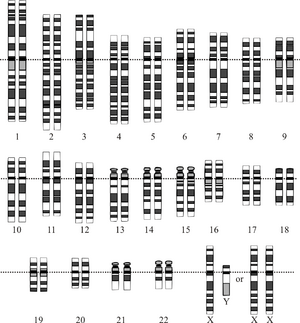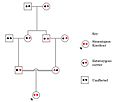Human genome facts for kids

The human genome is like a complete instruction book for building and running a human body. It's made of DNA, which holds all our genetic information. This information is stored in 23 pairs of chromosomes inside the cell nucleus of almost every cell. There's also a tiny bit of DNA in the mitochondrial DNA, which are like the powerhouses of our cells.
Scientists have learned a lot about the specific order of the DNA "letters" (called sequences) on our chromosomes. We are still learning exactly what all this DNA does. Using this knowledge to help people is a new and exciting field.
Contents
The Human Genome Project
The Human Genome Project (HGP) was a huge scientific effort. It aimed to read and map all the genes in human DNA. This project created a "reference sequence" of the human genome. This reference is now used by scientists and doctors all over the world.
Major scientific journals like Nature and Science published the first drafts of this sequence in 2001. These papers explained how the DNA sequence was found. They also shared early ideas about what the sequence meant. Better versions of the sequence were released in 2003 and 2005. These improved versions filled in about 92% of the human genome.
A newer project called ENCODE is now studying how our genes are controlled. It looks at which genes are turned on or off and when.
DNA, Genes, and Proteins
The human genome has a little over 20,000 genes that make proteins. This number was actually much lower than scientists first thought! Only about 1.5% of our genome actually gives instructions for making proteins. The rest of the DNA has other important jobs. It includes non-coding RNA genes, parts that control how genes work (called regulatory sequences), and sections called introns.
Even though we have about 20,000 protein-coding genes, a single gene can make many different proteins. This happens through a process called RNA splicing. Think of it like a recipe that can be read in different ways to make different dishes. For example, one gene in a fruit fly can make 38,000 different types of mRNA. Each of these mRNAs then leads to a different protein.
Because of RNA splicing and other changes after proteins are made, the total number of unique human proteins could be in the millions. This shows that most of our DNA is not "junk." At least 80% of the human genome has important functions.
How Humans and Chimpanzees Compare
Our closest living animal relatives are chimpanzees. When scientists first looked at simple DNA changes, they found that about 98.4% of human and chimpanzee DNA seemed the same. This was based on changes in single DNA "letters."
However, a more complete look at the chimpanzee genome was published in 2005. It showed a different picture. Scientists compared the parts of human and chimpanzee DNA that were similar enough to be lined up. This included about 2,400 million of the human genome's 3,164.7 million DNA "letters." This means about 75.8% of the human genome could be directly compared.
Within this 75.8% of comparable DNA, there is a 1.23% difference in single DNA "letters." Other differences, like missing or extra pieces of DNA (called "indels"), add another 3% difference. Also, large sections of DNA can be copied different numbers of times in each species. This adds another 2.7% difference. So, the total similarity between human and chimpanzee genomes could be as low as about 70%.
Related pages
Images for kids
See also
 In Spanish: Genoma humano para niños
In Spanish: Genoma humano para niños



